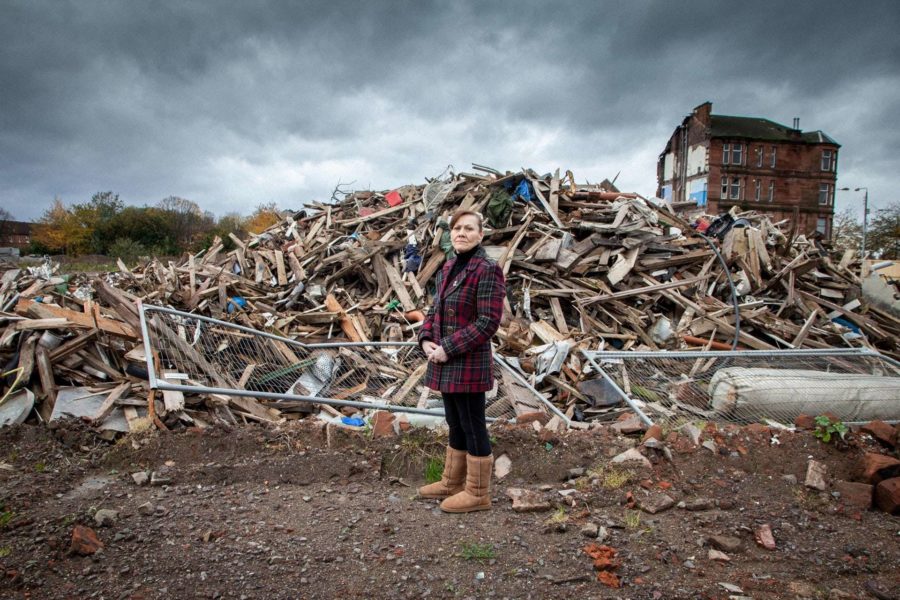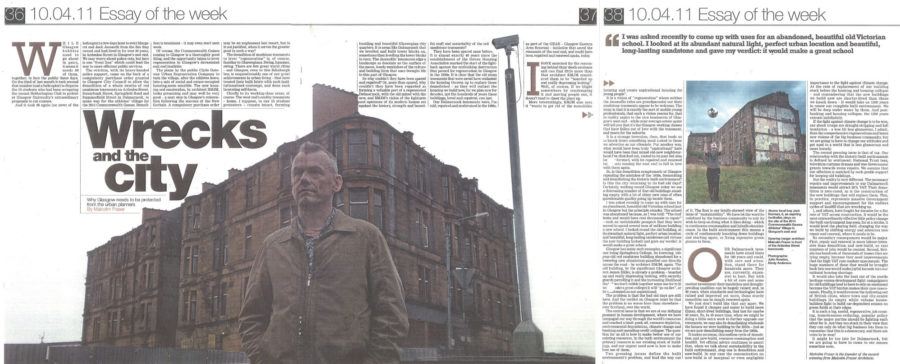There’s an uncanny thing, when you go onto Google Earth, out the East End of Glasgow below Celtic Park and near the big bend of the Clyde. If you use the wee mannie of Street View to go down onto the site of the old Ardenlea Street in Dalmarnock you land in the middle of the regenerated, post-Commonwealth-legacy Dalmarnock of 2015 with its smart terraces, photovoltaic roofs and traffic calming; but if you double-click to move north up the street it suddenly slips back into imagery from 2009 and you stand on grassy wasteland with, in the distance, the red sandstone tenements that were demolished for the regeneration. Click north again and you time travel forward to today, the red sandstone ghosts slipping into the past.
It’s a Chris Leslie moment, a Remembrance of Things Past with its elegiac evocation of a time and a place now wiped from the physical face of the earth. Glasgow’s full of such ghosts: look at Alasdair Gray’s beautifully evocative “Cowcaddens Streetscape in the Fifties” painting and note his comment that “all but a few distant buildings are demolished now”, or consider his great novel, “Lanark”:
“Glasgow is a magnificent city”, said McAlpin. “Why do we hardly ever notice that?”
“Because nobody imagines living here”, said Thaw… “Think of Florence, Paris, London, New York. Nobody visiting them for the first time is a stranger because he’s already visited them in paintings, novels, history books and films. But if a city hasn’t been used by an artist, not even the inhabitants live there imaginatively.”
Glasgow has been beautifully-imagined since – not least in the film “Under the Skin” – but much of the great and resonant city Gray imagined has gone, victim of a form of urban “regeneration” that likes a clean slate, shorn of its past, people and buildings, to create the future on.

Publication / Disappearing Glasgow, edited by Chris Leslie.
On the eviction of the last residents and demolition of several streets of handsome red sandstone tenements in Dalmarnock, in the East End of Glasgow, to clear the site for the new Commonwealth village.
Glasgow’s past-war mania for destruction and highways devastated Dalmarnock. Once a thriving and incredibly productive centre, employing tens of thousands in its dyeworks, wireworks and steel industries, including those at Sir William Arrol & Co who built the Forth Railway and Road Bridges, industrial decline and “slum clearance” demolition through to the 1970s left it a wasteland, its population battered down from over 50,000 in the 1950s to less than 2,000.
Towards the end of the 1970s, as we saw the estates and environments we were replacing our old communities with start to fail and began to recognise the craft and value in the beautifully constructed sandstone tenements we were sending to landfill, some saw the folly in what we were doing. Leading the way was the pioneering GEAR – the Glasgow Eastern Area Renewal project – which, between 1976 and 1987, carefully repaired huge numbers of tenements across the east end, including four streets of red sandstone tenements around Ardenlea Street, which stood strong in the surrounding wasteland.
So, along with the wasteland and its associated high levels of deprivation and unemployment, and the low life-expectancy that blights the East End of Glasgow, the pre-Games Dalmarnock of 2009 had remnants of a strong, solid past – and an exemplar of repair-based regeneration. It also had some solid, strong and listed Victorian schools, including the beautiful red sandstone London Road School, set in front of Celtic Park – and, of course, Celtic Park itself, a 60,000-person footfall magnet and sporting icon that was a gift to regeneration.
If the once-thriving Dalmarnock suffered the misfortune of becoming, in the words of Ian Manson, chief executive of the Clyde Gateway government-funded regeneration company, “the greatest concentration of derelict industrial land in Scotland”, it has since had the good fortune of being the recipient, through Clyde Gateway, of unrivalled regeneration focus and riches – according to then Council Leader, Steven Purcell “the best chance in a generation and possibly a lifetime, to improve the lives and raise the aspirations of every Glaswegian”. But while the cultural legacy of what is widely regarded as a happy Commonwealth Games, that showed Scotland and Glasgow, in particular, in a positive light, the legacy for the built environment is decidedly mixed.
The most significant failures lie in the regeneration masterplan’s two big moves: the brutal, six-lane “East End Regeneration Route” that has been driven through the heart of Dalmarnock, severing east from west, and the Commonwealth/Emirates Arena and Sir Chris Hoy Velodrome plonked off it, opposite Celtic Park. The Route continues the 1960’s plans for a highway box to serve Glasgow – as if the mania for “regeneration” destruction by urban motorway that characterised the worst of past-war planning was some malignant, undead Terminator figure, that had unfinished business with the East End, and rose again to complete its work. Plans for its £60 million extension have just been approved – Motorways Make Glasgow, as the PR puff should go.
The Route’s junction with London Road is one of the bleakest urban places I know. With a rich East End history of Glasgow Crosses to draw on – historic urban focusses – and the great urban magnet of Celtic Park augmented by the £113 million investment in the new Arenas, we might have hoped for somewhere defined as a vibrant place, instead of a massive traffic intersection with lumps of dumb buildings set at odd angles to it. And we might have hoped that the London Road School would have been incorporated into the masterplan and its history valued, instead of being demolished for a newbuild Celtic Museum and Superstore, becoming another ghost.
A better primary move was to situate the athlete’s village down towards the Cuningar Loop of the Clyde. Glasgow regeneration has tended to focus on tenemental living, and I have heard urban leaders from the city sneer at the idea of sunny family gardens, as if its citizens are bred too urban-hard to care for nature. But the car-calmed, family-oriented mix of terraces and flats open-out nicely to the loop of the river, and the post-athlete sales have gone well, with a good, contemporary Glasgow community growing here.
The pity is that, to achieve it, more malignant 1960’s “Terminator” clearance was employed to demolish the streets of red sandstone tenements that the GEAR project had earlier saved. These tenements were beautifully constructed, their built-to-lastness the epitome of sustainability, and if they had been situated in Glasgow’s West End would have been loved and full of young and old. But in the East End they had been abandoned and, as we tend to blame the built environment for poverty and social and economic dysfunction, were demonised as “boarded up and really depressing looking”, “monolithic housing” that got in the way of “aspirational housing for young people” – with Chris Leslie’s distressing record of their last residents being forcibly removed, at vast public expense, a shameful swansong.
There was no lack of space for the new athlete’s village homes to have worked around and repaired them (much of the industrial land still awaits development), just a collective failure to imagine a community that was not straight out of an advertising copywriter’s “aspirational” puff – that had old Glasgow people amongst it, that mixed old Glasgow tenements with new garden homes and that honoured the work of the GEAR by seeing a future Glasgow where, instead of endless cycles of construction, demonisation and destruction, all to suit the interests of the regeneration industry, we had the old Glasgow – its people, places and buildings – working together with an aspirational new one.

Further Reading
Wrecks and the City, Malcolm Fraser, Sunday Herald, 2011 (download .pdf)
Disappearing Glasgow, Chris Leslie, 2016.

